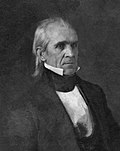Politics

Historian Yonatan Eyal argues that the 1840s and 1850s were the heyday of the faction of young Democrats that called itself "Young America". Led by Stephen Douglas, James K. Polk and Franklin Pierce, and New York financier August Belmont, this faction broke with the agrarian and strict constructionist orthodoxies of the past and embraced commerce, technology, regulation, reform, and internationalism. [2]
In economic policy Young America saw the necessity of a modern infrastructure of railroads, canals, telegraphs, turnpikes, and harbors; they endorsed the "Market Revolution" and promoted capitalism. They called for Congressional land grants to the states, which allowed Democrats to claim that internal improvements were locally rather than federally sponsored. Young America claimed that modernization would perpetuate the agrarian vision of Jeffersonian Democracy by allowing yeomen farmers to sell their products and therefore to prosper. They tied internal improvements to free trade, while accepting moderate tariffs as a necessary source of government revenue. They supported the Independent Treasury (the Jacksonian alternative to the Second Bank of the United States), not as a scheme to quash the special privilege of the Whiggish moneyed elite, but as a device to spread prosperity to all Americans. [3]
The movement's decline by 1856 was due to unsuccessful challenges to "old fogy" leaders like James Buchanan, to Douglas' failure to win the presidential nomination in 1852, to an inability to deal with the slavery issue, and to rising isolationism and disenchantment with reform in America. [4]
Manifest Destiny
When O'Sullivan coined the term "Manifest Destiny" in an 1845 article for the Democratic Review, he did not necessarily intend for American democracy to expand across the continent by force. In effect, the American democratic principle was to spread on its own, self-evident merits. The American exceptionalism often attached to O'Sullivan's "Manifest Destiny" was an 1850s perversion that can be attributed to what Widmer called "Young America II". [5] O'Sullivan even contended that American "democracy needed to expand in order to contain its ideological opponent (aristocracy)". [6] Unlike Europe, America had no aristocratic system or nobility against which Young America could define itself. [7]
Literature
Aside from Young America's promotion of Jacksonian Democracy in the Democratic Review, the movement also had a literary side. It attracted a circle of outstanding writers, including William Cullen Bryant, George Bancroft, Herman Melville, and Nathaniel Hawthorne. They sought independence from European standards of high culture and wanted to demonstrate the excellence and "exceptionalism" of America's own literary tradition. Other writers of the movement included Evert Augustus Duyckinck, Cornelius Mathews, [8] It was Mathews that adopted the name for the movement. In a speech delivered June 30, 1845, he said:
Whatever that past generation of statesmen, law-givers and writers was capable of, we know. What they attained, what they failed to attain, we also know. Our duty and our destiny is another from theirs. Liking not at all its borrowed sound, we are yet (there is no better way to name it,) the Young America of the people: a new generation; and it is for us now to inquire, what we may have it in our power to accomplish, and on what objects the world may reasonably ask that we should fix our regards. [9]
One of Young America's intellectual vehicles was the literary journal Arcturus. Herman Melville in his book Mardi (1849) refers to it by naming a ship in the book Arcturion and observing that it was "exceedingly dull", and that its crew had a low literary level. [10] The North American Review referred to the movement as "at war with good taste". [11]
Hudson River School

Apart from literature, there was a distinct element of art associated with the Young America Movement. In the 1820s and 1830s, American artists such as Asher B. Durand and Thomas Cole began to emerge. They were heavily influenced by romanticism, which resulted in numerous paintings involving the physical landscape. But it was William Sidney Mount who had connections to the writers of the Democratic Review. And as a contemporary of the Hudson River School, he sought to use art in the promotion of the American democratic principle. O'Sullivan's cohort at the Review, E. A. Duyckinck, was particularly "eager to launch an ancillary artistic movement" that supplemented Young America. [12]
